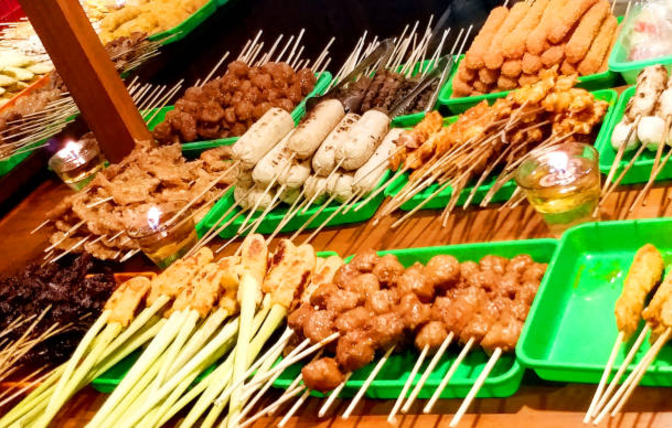

Introduction to Indonesian Street Food Culture
There are more than 17,000 islands to explore in Indonesia, and Indonesian street food is culinary paradise. Indonesian street food is not merely cheap eats – it's a way of life, one that is deeply rooted in society and culture. From night markets in Jakarta to Bali street food stalls along the roadsides, street food is part of the entire travel experience.
Locals would tell you, "If you wish to know Indonesia, eat like an Indonesian." And it starts on the streets.
Why Indonesian Street Food is Special
While most of the other nations in Asia have street food with influences mainly from one source, Indonesian street food has varied flavors from indigenous traditions, Chinese, Indian, and Middle Eastern trade.
This is why it's special:
Variety of Locations: There is a dish in every island that carries its name.
Intense Use of Spices: Galangal, turmeric, chili, and lemongrass are a favorite.
Social Sharing: Some street foods are sharing foods.
Convenience: Food is typically delicious and less than $2.
Sweet, spicy, salty, or refreshing, Indonesian street food has something to satisfy every palate.
1. Nasi Goreng – The National Fried Rice
Nasi Goreng is not fried rice – it's a national icon. It is cooked using sweet soy sauce, shrimp paste, garlic, and chili, and sometimes topped with a fried egg and crunchy crackers.
Travelers enjoy it because it's:
Quick and filling
Affordable everywhere
Simple to make yourself using chicken, shrimp, or beef
Where to eat: Yogyakarta street food stalls and Bali night markets.
2. Satay (Sate) – Meat Skewer Flavor Bombs
Satay is meat cooked on a stick and served with peanut sauce. From chicken to goat, even fish, the smoky flavor wins people over instantly.
A must-try version: East Java's Sate Madura, renowned for its sweet-hot marinade.
3. Bakso – Indonesian Comfort Meatball Soup
Bakso is a hot meatball dish in soup served with noodles, fried shallots, and sambal (chili paste). Even the previous US President Obama once claimed it as his favorite Indonesian dish!
Tip: Do try Bakso Malang, which comes with fried dumplings and tofu.
4. Gado-Gado – Peanut-Spinning Salad
A sinful yet healthy snack, Gado-Gado combines boiled vegetables, eggs, tofu, and lontong (rice cakes) with nutty peanut sauce.
It's Indonesia's version of a power salad – light, crispy, and packed with protein.
5. Martabak – Savory Sweet Pancake
Martabak is the gem of Indonesian street food.
Martabak Manis (Sweet): Filling with chocolate, cheese, peanuts, and evaporated milk.
Martabak Telur (Savory): Spiced omelette wrapped in dough.
At best enjoyed at Jakarta and Surabaya night markets.
6. Soto – Traditional Indonesian Soup
Soto is a scented soup that consists of turmeric soup, vermicelli, meat, and herbs. There is a local version of each region, from Soto Betawi (Jakarta) to Soto Lamongan (East Java).
7. Pisang Goreng – Fried Banana Heaven
Too simple to be addictive, Pisang Goreng (fried banana) are crinkly on the outside and soft within and sometimes garnished with a sprinkling of chocolate or cheese.
Ideal for a tea time treat.
8. Nasi Padang – A Feast of Flavors
Originating from West Sumatra, Nasi Padang is a banquet rice buffet with up to 20 side dishes like Rendang, Gulai, and Sambal Ijo.
Fun fact: You only pay for what you eat, even though there are towering piles of food on the table.
9. Ayam Penyet – Smashed Fried Chicken
Ayam Penyet translates as "smashed chicken." Smashed fried chicken is accompanied by sambal, cucumber, and rice.
Warning: The chili paste is hot!
10. Kerak Telor – Jakarta Heritage Omelet
Betawi dish, Kerak Telor is egg-filled sticky rice omelet with coconut shreds and fried onions. Originally sold at Jakarta fairs, it's a flavor of the past.
11. Es Cendol – Sweetness of Dessert Drink
Es Cendol (or Dawet) is sweet ice drink flavored with coconut milk flavor and green rice flour jelly with palm sugar syrup flavor.
Ideal to drink after spicy dishes.
12. Pecel Lele – Catfish Sambal
Catfish fried by vendors all over Indonesia and always accompanied by steaming sambal and rice. It's cheap, filling, and loved by workers and students.
13. Tahu Gejrot – Sour Tofu Snack
One of Cirebon specialty dishes, Tahu Gejrot is drenched tofu that's broken into pieces and covered with sweet-sour tamarind sauce and chilies and garlic.
14. Siomay – Indonesian Steamed Dumplings
Chinese-influenced, Siomay are steamed fish dumplings served with peanut sauce and steamed vegetables. Inexpensive and high in protein, it's a lunch favorite.
15. Rujak – Spicy Fruit Tropical Salad
Rujak is tropical fruit such as mango, pineapple, and papaya combined with spicy palm sugar-chili dressing. It's sweet, sour, and spicy all at once
Where to Eat the Best Indonesian Street Food
Jakarta: Street-side warungs and night markets
Bali: Night bazaars and beachside stalls
Yogyakarta: Malioboro Street
Surabaya: Pasar Atom market
Bandung: Street carts and food trucks
For more on Southeast Asia street food, visit Lonely Planet's guide
Safe Street Food Eating Tips
Select busy stalls with high turnover
Inspect food served hot
Avoid raw food if in doubt
Consume bottled water
It is okay to ask locals for advice
FAQs
1. Is Indonesian street food safe for tourists to eat?
Yes, as long as you select busy stalls and freshly cooked food.
2. What is the hottest Indonesian street food?
Ayam Penyet and Sambal-based dishes are the most fiery.
3. Is Indonesian street food vegetarian?
Absolutely! Try Tahu Gejrot, Gado-Gado, and Pisang Goreng.
4. Indonesian street food: how much?
Most of it is approximately $1-$3, so it is cheap.
5. What is the best drink to have with spicy Indonesian food?
Anggur or any fizzy drink will suffice.
Es Cendol or Teh Botol (sweet cold tea) are good friends.
6. Which city boasts the best street food in Indonesia?
Yogyakarta might be gastronomic heaven, but Jakarta and Bandung must be given equal consideration too.
Conclusion
Indonesian street food is not just food – it's a reflection of the country's culture, diversity, and friendliness. From hot spicy satay to cool cold Es Cendol, every bite is a story of tradition and flavor.
The next time you're in Indonesia, forget about the sophisticated restaurants and get straight onto the streets – that is where all the sorcery happens.


